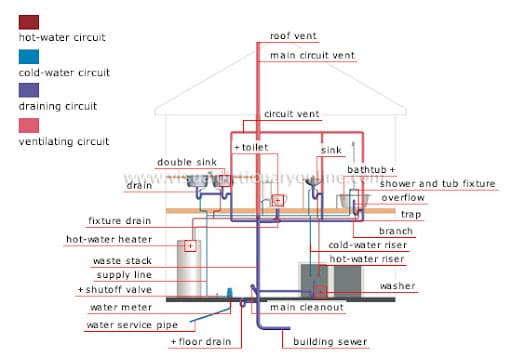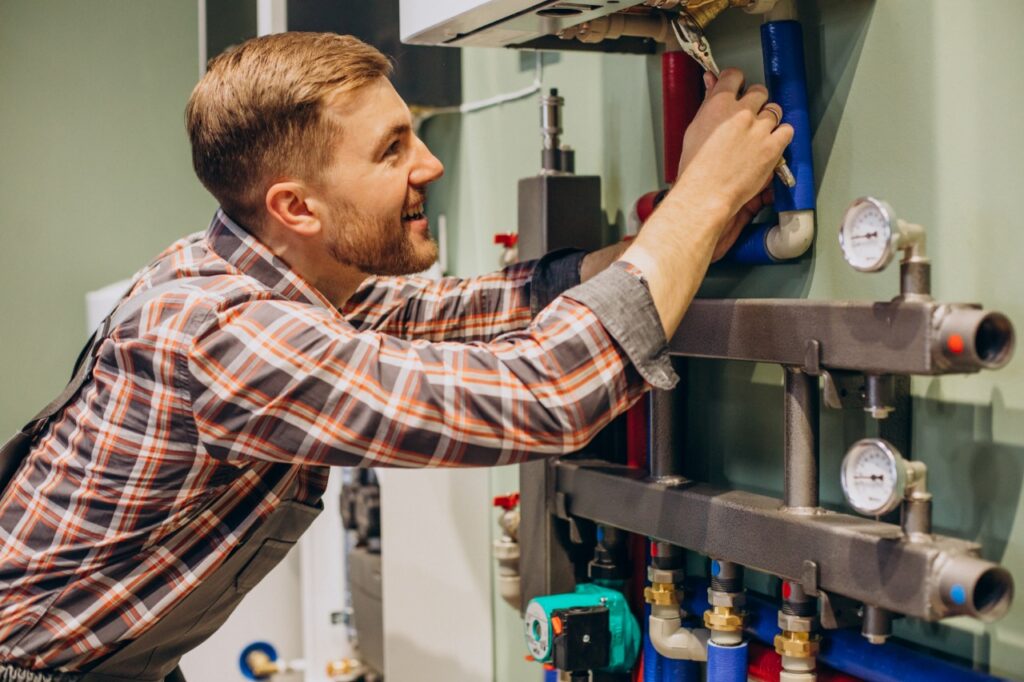How Your Home's Plumbing System Works: Design
How Your Home's Plumbing System Works: Design
Blog Article
How do you feel in relation to Plumbing Installation 101: All You Need to Know?

Understanding exactly how your home's plumbing system functions is important for every single house owner. From supplying clean water for alcohol consumption, cooking, and showering to securely removing wastewater, a properly maintained plumbing system is vital for your family's wellness and convenience. In this extensive guide, we'll explore the complex network that composes your home's plumbing and deal tips on upkeep, upgrades, and managing usual problems.
Introduction
Your home's plumbing system is greater than just a network of pipelines; it's a complex system that ensures you have accessibility to clean water and effective wastewater elimination. Understanding its elements and just how they interact can help you stop costly repair work and make certain every little thing runs smoothly.
Fundamental Parts of a Pipes System
Pipes and Tubes
At the heart of your pipes system are the pipes and tubing that lug water throughout your home. These can be made of various products such as copper, PVC, or PEX, each with its benefits in regards to resilience and cost-effectiveness.
Components: Sinks, Toilets, Showers, and so on.
Fixtures like sinks, commodes, showers, and bathtubs are where water is made use of in your house. Understanding exactly how these components attach to the plumbing system aids in identifying troubles and intending upgrades.
Shutoffs and Shut-off Points
Valves manage the circulation of water in your pipes system. Shut-off valves are essential throughout emergency situations or when you need to make repair services, allowing you to isolate parts of the system without interrupting water circulation to the entire home.
Water System
Key Water Line
The main water line links your home to the metropolitan water supply or a personal well. It's where water enters your home and is dispersed to different components.
Water Meter and Stress Regulator
The water meter steps your water usage, while a stress regulatory authority makes certain that water flows at a risk-free pressure throughout your home's pipes system, avoiding damages to pipelines and fixtures.
Cold Water vs. Hot Water Lines
Recognizing the distinction between cold water lines, which provide water directly from the main, and hot water lines, which bring warmed water from the hot water heater, helps in repairing and planning for upgrades.
Drainage System
Drain Piping and Traps
Drain pipes lug wastewater far from sinks, showers, and toilets to the sewer or sewage-disposal tank. Traps stop sewage system gases from entering your home and additionally trap debris that could cause blockages.
Ventilation Pipes
Air flow pipelines enable air into the water drainage system, preventing suction that could slow drainage and trigger traps to empty. Appropriate ventilation is vital for preserving the honesty of your pipes system.
Value of Correct Water Drainage
Making certain appropriate drainage prevents back-ups and water damages. On a regular basis cleansing drains pipes and preserving catches can stop expensive repair work and prolong the life of your plumbing system.
Water Heating System
Sorts Of Hot Water Heater
Hot water heater can be tankless or traditional tank-style. Tankless heaters warmth water on demand, while storage tanks save warmed water for prompt usage.
Updating Your Pipes System
Factors for Updating
Upgrading to water-efficient fixtures or replacing old pipes can improve water quality, reduce water costs, and boost the value of your home.
Modern Pipes Technologies and Their Benefits
Explore modern technologies like wise leak detectors, water-saving commodes, and energy-efficient hot water heater that can save money and lower ecological effect.
Cost Factors To Consider and ROI
Determine the in advance prices versus long-lasting savings when taking into consideration pipes upgrades. Lots of upgrades pay for themselves through minimized utility expenses and fewer fixings.
Exactly How Water Heaters Connect to the Pipes System
Comprehending just how hot water heater connect to both the cold water supply and hot water distribution lines aids in identifying issues like inadequate warm water or leaks.
Maintenance Tips for Water Heaters
Frequently flushing your hot water heater to remove debris, checking the temperature level settings, and inspecting for leakages can prolong its lifespan and enhance energy performance.
Common Plumbing Concerns
Leaks and Their Reasons
Leaks can take place because of maturing pipes, loosened fittings, or high water stress. Addressing leaks immediately avoids water damages and mold growth.
Blockages and Blockages
Blockages in drains pipes and bathrooms are usually triggered by purging non-flushable items or an accumulation of grease and hair. Utilizing drain displays and being mindful of what goes down your drains pipes can prevent blockages.
Signs of Plumbing Problems to Watch For
Low tide pressure, slow-moving drains, foul odors, or abnormally high water bills are indicators of prospective pipes problems that must be resolved quickly.
Plumbing Upkeep Tips
Regular Evaluations and Checks
Arrange yearly plumbing evaluations to capture concerns early. Search for indications of leakages, corrosion, or mineral buildup in taps and showerheads.
Do It Yourself Upkeep Tasks
Straightforward tasks like cleaning tap aerators, looking for commode leaks utilizing color tablet computers, or shielding exposed pipes in cold climates can stop significant pipes issues.
When to Call a Professional Plumbing
Know when a pipes concern calls for professional competence. Trying intricate fixings without proper knowledge can lead to more damages and greater fixing prices.
Tips for Lowering Water Use
Simple routines like dealing with leakages without delay, taking much shorter showers, and running complete lots of washing and recipes can save water and lower your utility expenses.
Eco-Friendly Plumbing Options
Take into consideration lasting pipes products like bamboo for floor covering, which is durable and green, or recycled glass for kitchen counters.
Emergency Preparedness
Steps to Take During a Plumbing Emergency
Know where your shut-off valves lie and just how to switch off the water in case of a ruptured pipeline or significant leak.
Importance of Having Emergency Situation Calls Convenient
Maintain get in touch with details for neighborhood plumbing professionals or emergency services readily offered for fast action during a plumbing situation.
Ecological Effect and Conservation
Water-Saving Components and Devices
Setting up low-flow taps, showerheads, and commodes can substantially decrease water usage without giving up efficiency.
DIY Emergency Fixes (When Applicable).
Short-lived fixes like making use of air duct tape to patch a dripping pipeline or putting a bucket under a dripping tap can minimize damages up until a professional plumber shows up.
Conclusion.
Recognizing the anatomy of your home's pipes system equips you to maintain it properly, conserving time and money on fixings. By complying with regular upkeep routines and remaining notified about modern-day plumbing technologies, you can ensure your pipes system operates efficiently for years ahead.
HOW YOUR PLUMBING SYSTEM WORKS
Which Pipes Do What?
Blue lines = fresh water supply entering the building Red lines = hot water supply entering the building Grey lines = pipes carrying waste away from the building and venting pipes carrying gases away from the building (through the roof) YOUR MAIN PLUMBING SYSTEMS
There are two main plumbing systems that support your home s basic plumbing needs one that brings clean water into your home, and one that sends dirty water away from your home. Connected to the toilet, bath, shower, and other faucets in your home, these two systems keep your water flowing in the right directions.
ACCESSING FRESH WATER
Fresh and clean water is brought into your home through the main water supply line . Filtered through one pipe, this water is pressured to flow into the various fixtures in your home at any given time.
This water can be sourced from a well located on your property, a pond or river (mostly cottages), or, as in most cases, from the city s municipal water treatment centre. However, it is important to note that water that is untreated, such as the water siphoned from ponds or rivers, may not be safe to drink. Personal water supplies always need to be treated for hardness and contaminants before consumed.
MUNICIPAL WATER SUPPLIES
Improve taste and odour Remove sediment Eliminate hardness Reduce chlorine COLD WATER SUPPLY VS. HOT WATER SUPPLY
Cold water flows into your home or building through the service line, which then distributes hot or cold water to your fixtures. This line is most commonly run through a central column that runs floor to floor. Hot water runs in short and straight pipes as the longer the pipeline, the more heat that will be lost in the transfer. Having shorter pipes also allows residents to access hot water more quickly.
WASTE WATER SYSTEM
Your wastewater system is divided into two parts pipes that send wastewater away from your home and venting pipes that send sewer gas away from your home. Sewage water travels through pipes that flush the water and waste towards local sewers that are operated and managed by your city or town. Most sewer systems rely on gravity to move the wastewater to where it needs to go.
The further away from your toilet or sink, the larger wastewater pipes become. This allows for waste to be disposed of from various parts of your home or business at once without pipe blockages. The angle and flow of these pipes are also essential for keeping your waste pipes clear of build up.
https://harrisplumbing.ca/how-your-home-plumbing-system-works/

I was shown that report about Understanding Your Home's Plumbing Anatomy from someone on a different blog. Enjoyed our entry? Please share it. Let other people check it out. Many thanks for going through it.
Go Company Report this page